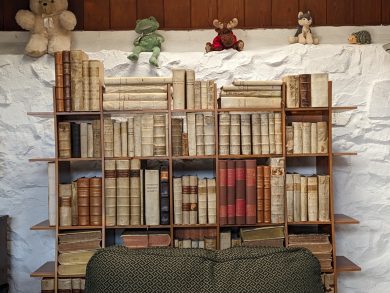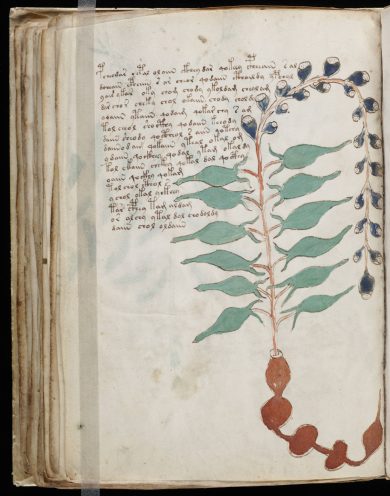Carla Freccero is Distinguished Professor of Literature and History of Consciousness, and Affiliated Faculty in Feminist Studies at UCSC, where she has taught since 1991. Her books include Father Figures (Cornell,1991); Popular Culture (NYU, 1999); and Queer/Early/Modern (Duke, 2006). She co-edited Premodern Sexualities (Routledge, 1996); Species/Race/Sex, a special issue of American Quarterly 65.3 (2013); and Animots, a special issue of Yale French Studies 127 (2015). Her current book project, on nonhuman animals and figuration, is Animate Figures. Her fields include early modern European literature and history; critical theory; feminist and queer theories; popular culture and cultural studies; psychoanalysis and animal studies.
On Living Through Technological Revolutions
It’s been two and a half years since my father died, and it’s time to close up and sell his house, the house he bought in 1979 and lived in, on and off, since. He also threw almost nothing away that was not clearly garbage. I inherited his rare book collection. My father began life a third of the way into the 20th century, growing up in relative poverty in Corona, Queens, as the only child of Italian working-class immigrant parents. He and I lived through the same technological revolutions in the 20th and 21st century U.S., and both of us chose a past era on which to focus, a European era that also saw a major technological revolution—the invention and widespread use of the printing press and thus, printed books. Some of the books in my father’s collection date from that time. Some are also printed on and bound in parchment, dominant in Western Europe even after the introduction of cellulose paper, because parchment was a technology for encasing print that was sure to endure. Johannes Gutenberg, the early printer, even made his famous 1455 movable-type Bible in both vellum (a finer version of parchment made from calfskin) and paper as a hedge against time’s damage. Indeed, the vellum covers have fared better than many a modern bound book, and certainly better than the paper of the 20th century books I’ve tried to give away to make room for my father’s collection.

Part of John Freccero’s collection. Photo by Carla Freccero.
He cherished these rare books, but not the way an amateur collector does; he read them, used them for his work. They’re tattered, or in some cases unattractively rebound. They’re written in Latin, Italian, occasionally French. He bought them during his scholarly travels as a graduate student and assistant professor, back in the days when little rare bookshops were scattered all over Europe, the booksellers knowing well the content and value of their wares. He had other books too, what we’d call modern ones, many more than those in his rare collection. But neither these, nor the ones I’ve tried to give away, can find homes, orphans as they are of a past technological era, probably worth less, if monetary value is the measure, than the trees that gave them their leaves.

A page from the still-undeciphered Voynich Manuscript, consisting of 240 vellum pages, and thought to have been written in the 15th or 16th century.
The vellum, however, does more than mark an era; it dates and geographically locates each book, if one uses a late 20th century technology—DNA testing—to read it. It tells you what animal was sacrificed, sometimes which herd and what they were eating. Did the monks and printers know this aspect of vellum’s endurance? Surely not, and yet…When printers used paper, it was watermarked, another way to situate the provenance and ownership (introduced in Italy, I’m told, in 1282). We have “digital” watermarks now, too, another late 20th century technological innovation, though most of us probably cannot read them. Watermark has survived as a term for this method of identification, even though the technique no longer involves water, whereas vellum is mostly relegated to theological uses—the scrolls of the Torah, for example, or the decrees of the Catholic Church. Animal sacrifice persists in these traditions.
This experience of a technological revolution—print—is only one of many my father and I have shared. His dissertation was hammered out on a manual typewriter; mine was typed then entered into the mainframe (on several huge floppy disks) and printed on a dot matrix printer. I cannot read those floppy disks. My last book was composed entirely on a personal computer; I remember the moment when I no longer hand wrote before “typing” on a computer. But that’s not all; my father had a prodigious LP collection. LPs are “back” and so these have found collectors. I have a prodigious cassette tape collection—a technology that skipped him—and CDs too.
There is so much now that is “waste” and that emanates from the technological revolutions we’ve lived through, I notice as I catalog my melancholic attachments to: mix tapes, CDs, videotapes, DVDs, stereo systems (amps, pre-amps, tuners, speakers and sub-woofers), paperback books, handwritten letters, notes taken in class, rough drafts on paper or handwritten annotations on printed type, manuscripts of the books I’ve published, mountains and mountains of paper files—UCSC’s institutional history from 1991 on! And then, whenever I lament the loss of institutional memory and history because of the transition to digital, I remember that in Plato’s Dialogues the technology of writing came under that very same suspicion.
Whenever I lament the loss of institutional memory and history because of the transition to digital, I remember that in Plato’s “Dialogues” the technology of writing came under that very same suspicion.
When I was a junior in high school, I was cleaning the house one Saturday while my mother was working (my weekly chore). I left a candle burning in my room because I had run out of matches to light my cigarette (talk about obsolete tech!). Some time later I went upstairs and opened my bedroom door to find it in flames. I gathered the baby, the dog, and the cat and rushed out of the house to call the fire department. I lost everything I’d ever “owned” (if anyone who is a minor can own anything really) in that fire, and it marks my attachment to objects, as does the fact that we had not lived in any one place for very long up to that point and that my parents also lost their lifetime promise in that last transition, from a ranch house in the wilds of upstate New York to the tony suburban community of Madison, Connecticut. I still sometimes inquire about objects (and animals) that disappeared in that move. My friends joke that my parents made sandwiches from the thirty-two rabbits I tended and showed at 4-H fairs. But to experience the loss of objects suggests a plenitude that preceded the loss—the Syrian refugee who protests, “But I was a doctor!,” or the Palestinian farmer lamenting the razing of olive orchards painstakingly cultivated over decades. I do not know what my attachments would be if they were not linked to loss.
There’s an allegory there, but it cannot only be an allegory of loss. My mother, who is completely deaf, can hold a conversation on the phone with her children because her iPhone pairs with her hearing aids (although using a smart phone is a whole other challenge for a nonagenarian). A student of mine can read my annotations on documents because of text-to-speech (but it requires me to use track-changes to edit and comment). There are improvements as a result of the technological innovations, but there are downsides too, and sometimes I wish that folks would be somewhat less ecstatic and/or apocalyptic and try to think about what it would mean to “advance” technologically at a human or mammalian scale, for the benefit of the beings who are using it. And I want us to be curious about what seems too often relegated to obsolescence (including aging humans!) and to learn what the past, in its present lingering, might still offer.
To experience the loss of objects suggests a plenitude that preceded the loss.
This is one reason I like speculative fiction. Much of it imagines the technological innovations we would want (pace those flying cars we were promised in the fifties), including technologies of everyday life, technologies of governance and decision-making, technologies of care for the earth. They give me hope, not only because I can imagine the worlds crafted in those texts, but also because there are people who can imagine such worlds, imagine them better, and bring them into being virtually. They are my people, as is the humus to which I will return, in an ancient technology of biotemporality’s making.
Banner Image: Typewriter and laptop back-to-back, by Glenn Carstens-Peters.
The Humanities Institute’s 2024 Technology Series features contributions from a range of faculty and emeriti engaged in humanities scholarship at UC Santa Cruz. The statements, views, and data contained in these pieces belong to the individual contributors and draw on their academic expertise and insight. This series showcases the ways in which scholars from diverse disciplinary perspectives contend with the issues connected with our annual theme. Sign up for our newsletter to receive the latest piece in the series every week!